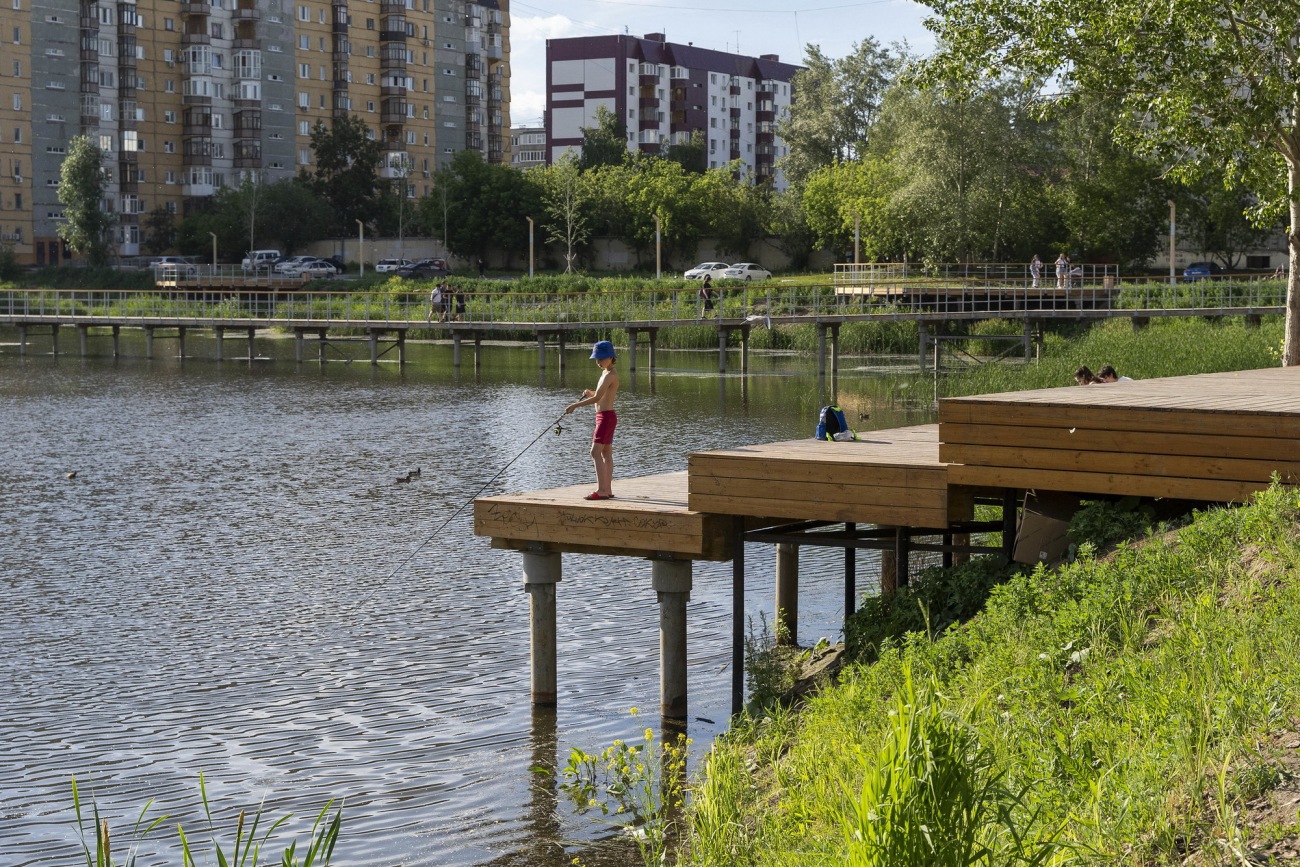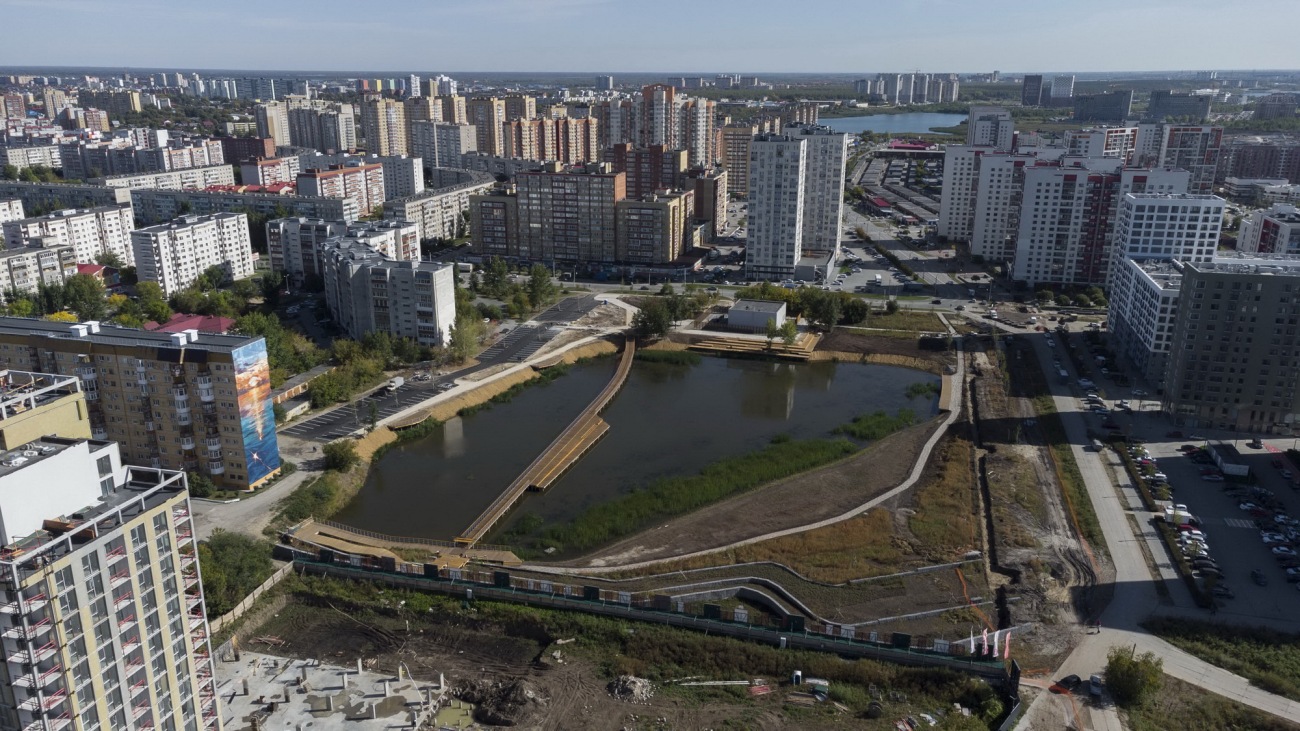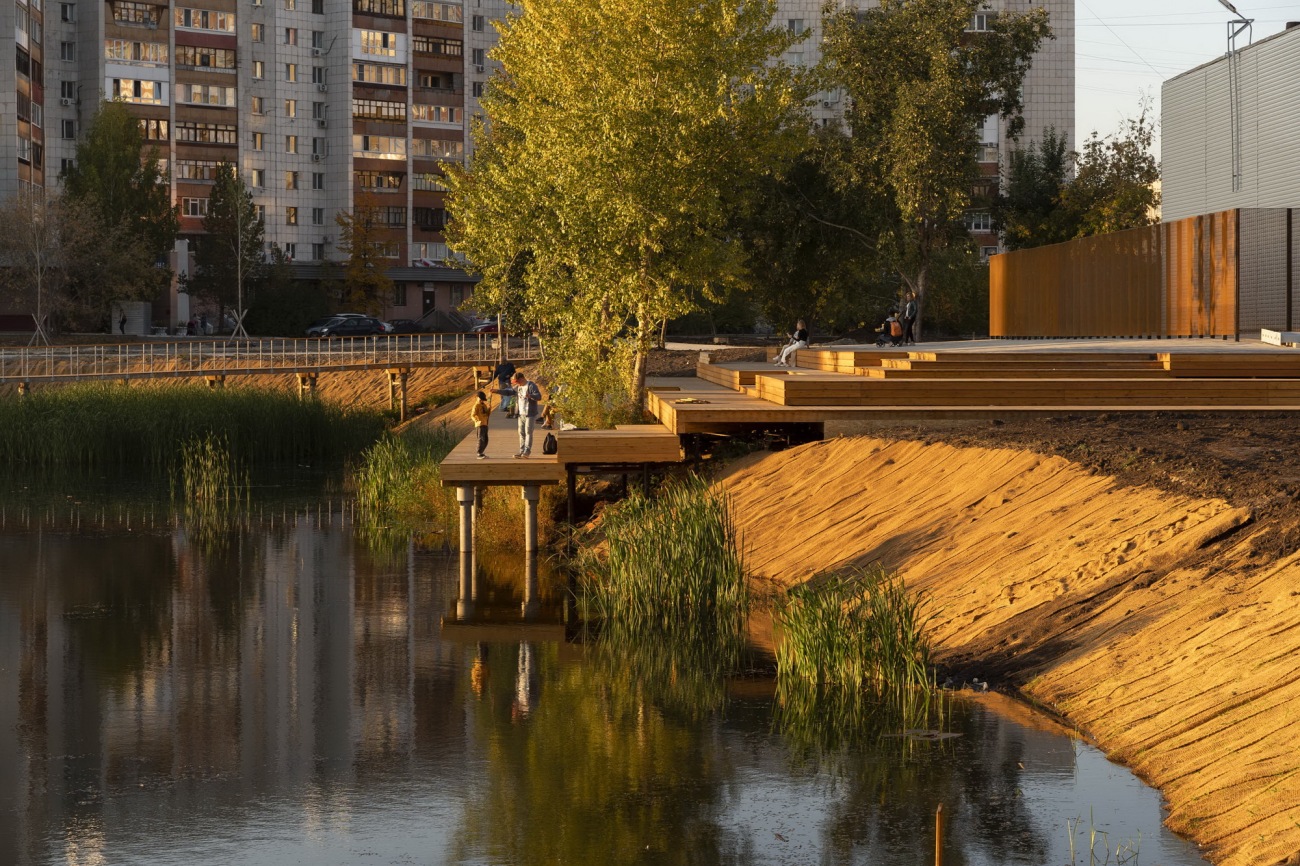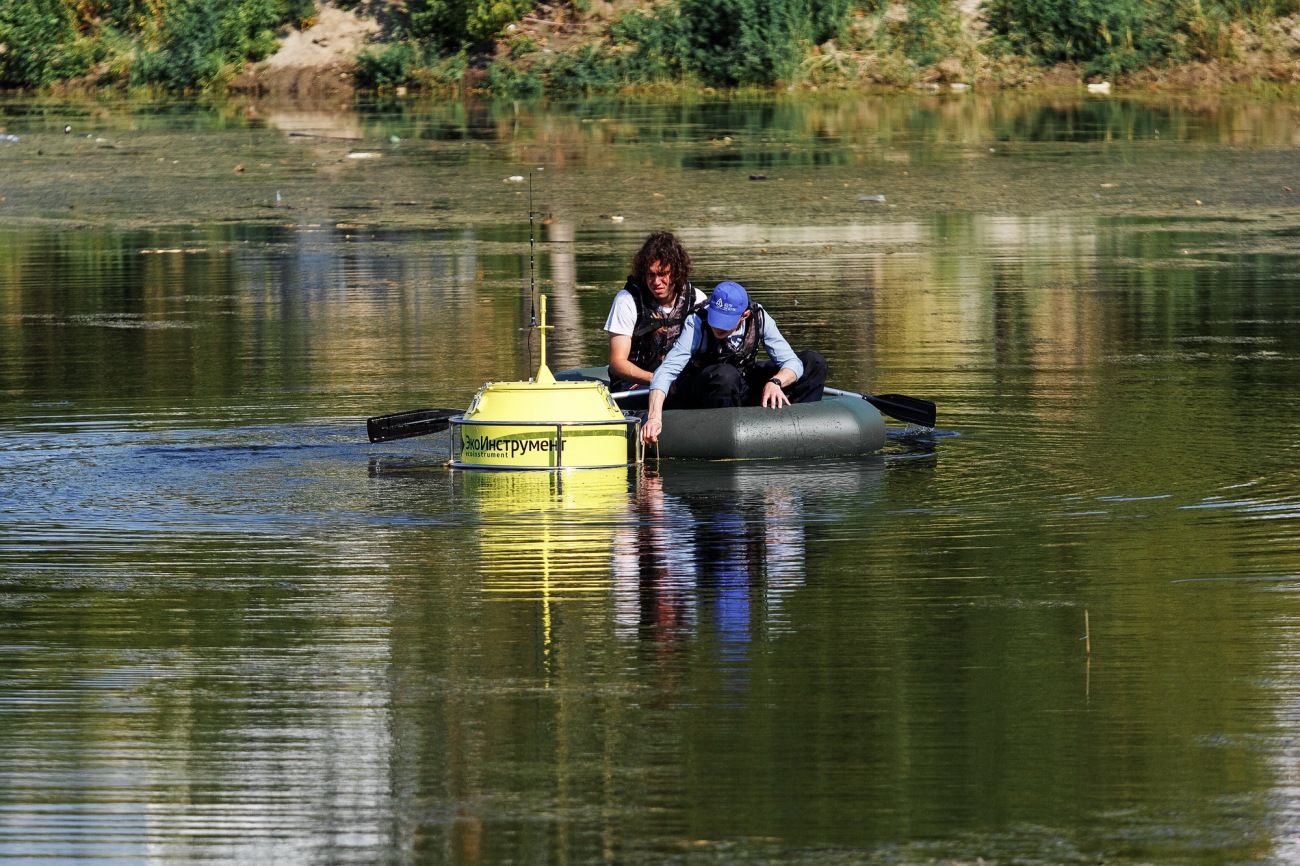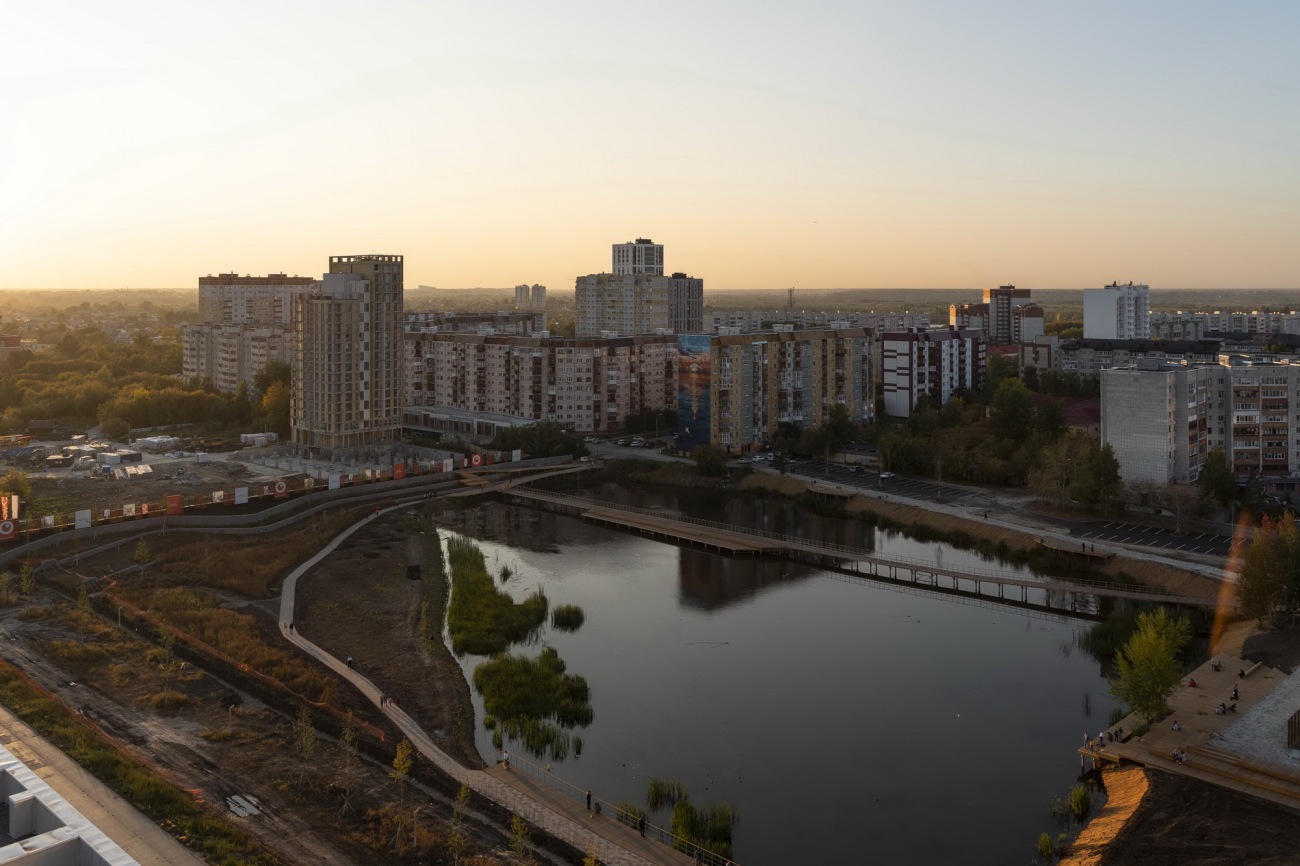Tikhoye湖位于俄罗斯西伯利亚的秋明市,靠近由开发公司 Brusnika 设计的住宅区项目。Tikhoye湖面积小、浅且泥泞,直到 20 世纪 70 年代才变得宽阔,但受混乱的城市发展影响,湖面逐渐萎缩。因此,在修建住宅区的同时,人们决定修复水库并美化湖岸,从而将新区与湖岸连接起来。
Tikhoye lake is located in Russian town Tyumen, in Siberia, near a residential area project designed by the development company Brusnika. A small, shallow and boggy Tikhoye lake was much wider up to the 1970s, but affected by chaotic urban development, it gradually shrank. As a result, while working on the residential area, it was decided to restore the reservoir and landscape its shoreline, thus linking the new quarter to the lake shore.
项目团队将复兴过程分为几个阶段。第一步是对湖泊、水和土壤进行生态评估。这项工作由 Brusnika 与北乌拉尔国立农业大学、俄罗斯生态学会和 ECOSTANDARD 小组合作完成。根据研究结果,制定了有关生物多样性、海岸线稳定、疏浚和鱼类放养的建议,并制定了恢复自然遗址的战略。
The project team divided the revitalisation process into several stages. The initial step comprised ecological evaluation of the lake, its water and soil. This was accomplished by Brusnika in collaboration with the The State Agrarian University of The Northern Trans-Urals, the Russian Ecology Society and ECOSTANDARD Group. Based on the results of the research, recommendations concerning biodiversity, shoreline stabilisation, dredging and fish stocking were formulated and a strategy to restore the natural site was developed.
据研究,由于 20 世纪 90 年代和 21 世纪初房地产开发的混乱,该湖与河流失去了联系。其面积大幅缩小,岸边被水淹没。布鲁斯尼卡立即采取行动,清理盆地和岸边的垃圾、枯木和腐烂植物。下一步是清除湖底的淤泥。为了实现这一目标,在湖的淤泥部分和好水部分之间修建了一座人工水坝。通过将 26,000 立方米的水从一个部分泵送到另一个部分,清除了 20,000 立方米的沉积物,使湖水深度从 1.4 米增至 2.5 米。2.7 千平方米的表面积保持稳定。清理湖底后,竖起了支撑墙以防止侵蚀,从而形成了更加清晰的椭圆形水面。
According to research, the lake lost connection to the river due to chaotic real estate development in the 1990s and early 2000s. Its area shrank considerably and the shores became waterlogged. Brusnika sprang into action by cleaning the basin and the shores from litter, dead wood and decaying plants. The next step was to remove silt from the bottom of the lake. In order to achieve this, an artificial dam between the silted and good parts of the lake was constructed. By pumping 26 000 cubic metres of water from one part to another, 20 000 cubic metres of sediment were removed, which resulted in deepening the lake from 1.4 to 2.5 metres. The surface area of 2.7 thousand square metres remained stable. After clearing the lake bottom, supporting walls were erected in order to prevent erosion, resulting in a better defined, oval water surface.
湖泊复兴的第二阶段涉及植树造林。湖区种满了各种植物,一直延伸到水边——柳树、榆树、杨树、桦树、小檗、接骨木、芦苇、藤条、溪椴、灯心草和莎草。由湿地植物制成的浮动生物平台负责为水体补充氧气,并保持自然场地的生物多样性。这些平台将成为鸟类的筑巢地和鱼类的食物来源。
The second phase of lake revitalization involves its afforestation. The lake's area was filled with a variety of plants cascading down to the water's edge—willows, elms, poplars, birches, barberries, elderberries, reeds, cane, brooklime, bulrushes, and sedges. Floating bio-platforms made of wetland plants are responsible for enriching the water with oxygen and maintaining the biodiversity of the natural site. These platforms will become nesting sites for birds and a food source for fish.
复兴的第三阶段包括建造一个带有人行道和自行车道的公园。布鲁斯尼卡项目将在湖周围和湖边地区修建雨水花园(目前,专家们已经为它们打下了基础)。这些花园将过滤雨水径流并将其引导至水库。
The third stage of revitalisation involves the creation of a park with pedestrian and bicycle paths. Around the lake and on the territories adjacent to it, Brusnika projects will feature rain gardens (currently, specialists have laid the foundation for them). These gardens will filter stormwater runoff and direct it into the reservoir.
景观设计理念旨在尽量减少人类对湖泊造成的压力,并打造专门的休闲小岛。根据项目,公园从一个小广场和一个木制露天剧场开始,一直延伸到岸边。旁边有躺椅和野餐点。沿着湖岸线设计了配有长椅的木制观景台,在最宽处有一座人行桥横跨湖泊。冬天,湖泊可以变成溜冰场。为了支持生物多样性和保护鸟类的繁殖地,公园里的灯光被保持在最低限度。人行道的定向照明将抑制光污染,使夜间散步变得舒适。
The landscaping concept is aimed to minimise man-induced stress for the lake and create dedicated recreational isles. According to the project, the park starts with a small square and a wooden amphitheatre descending right to the shore. A sun loungers and picnic sites are located next to it. Wooden vantage points complete with benches are conceived along the shoreline with a pedestrian bridge crossing the lake in its widest point. The lake could be transformed into a skating rink in winter. In order to support biodiversity and preserve birds’ breeding ground, the lights in the park are kept to a minimum. Targeted lighting of pedestrian paths will curb light pollution and make evening walks comfortable.
此外,布鲁斯尼卡还计划在海岸线上设立互动展台,介绍湖泊的动植物信息,并为儿童组织一条步行教育路线。
As well, Brusnika is planning to install interactive stands along the coastline with information about the flora and fauna of the lake and organize a walking educational route for children.
湖泊恢复的最后阶段是放养鱼类。2024 年春天,大约 50 公斤鲤鱼和 100 公斤鲢鱼和鳙鱼被放养到蒂霍耶湖。在放养鱼类之前,专家们进行了相关研究,测量了深度,绘制了湖泊地图,收集了水样,并确定了哪些物种最能适应这里的条件。鲤鱼、鲢鱼和鳙鱼相互补充,帮助它们生存。
The final stage of lake revitalization is fish stocking. In the spring of 2024, approximately 50 kg of carp and 100 kg each of silver carp and bighead carp were released into Tikhoye Lake. Prior to the fish stocking, specialists conducted relevant studies, measured the depth, created a lake map, collected water samples, and determined which species would best adapt to the conditions. Carp, silver carp, and bighead carp complement each other and aid in their survival.
复兴过程计划于 2024 年秋季完成。此后,布鲁斯尼卡将通过季节性监测来维持湖泊的游客。专家将监测冰盖厚度,在春季洪水和夏季干旱期间控制水位和水质,检查动物群、鸟类群和生物高原的状况、水生植物的开花情况以及海岸线的完整性。这将提高所采取措施的效率,并使水库成为具有高自然生物多样性的重要休闲设施和城市生态岛。在水库修复和自然自净后,大约 3-5 年后,业余钓鱼将可以在其中进行。
The revitalization process is planned to be completed by autumn 2024. After this Brusnika will retain patronage of the lake through seasonal monitoring. Specialists will monitor the thickness of the ice cover, control the level and quality of water during spring floods and summer droughts, check the state of fauna, avifauna and bioplateaus, flowering of aquatic plants and the integrity of the coastline. This will improve the efficiency of the measures taken and make the reservoir a significant recreational facility and eco-island of the city with high natural biodiversity. After restoration and natural self-purification of the reservoir, in approximately 3-5 years, amateur fishing will be possible on it.
Tikhoye湖是水体修复和随后的滨水开发的一个典范。该项目无缝结合了教育、生态和娱乐等多种功能,将该地区重新定义为“第三空间”。
Tikhoye Lake exemplifies the revitalisation of a water body with subsequent waterfront development. This project seamlessly combines several functions: namely, educational, ecological, and recreational, redefining the area as the ‘third place’.
▽鸟瞰图,Lake bird view
▽植物修复技术,Phytoremediation Technology
Credits
Surface area — 2700 m²
Water volume — 18 000 m³
Lake depth — 2,5 m
40 000 trees
100 000 shrubs
54 000 wetland plants
Project team
Ecological research — The State Agrarian University of the Northern Trans-Urals, the Russian Ecology Society, ECOSTANDARD Group
Landscape design — Novascape, Brusnika Design
Development and landscape — Brusnika
Photo — Alexander Saskov, Maxim Loskutov
Research — 2020
Project — 2020-2021
Completion — 2021-2024
更新日期:2024-09-11 15:43:38
非常感谢 Brusnika 带来的精彩项目, 查阅更多Appreciations towards Brusnika for sharing wonderful work on hhlloo. Click to see more works!





